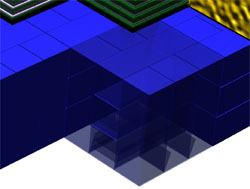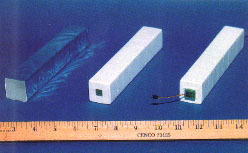|
Calorimeter
|
| The
|
calorimeter design for GLAST produces flashes of light that are used to determine how
much energy is in each gamma-ray. A calorimeter ("calorie-meter") is a device
that measures the energy (heat: calor) of a particle when it is totally absorbed.
CsI(Tl) bars, arranged in a segmented manner, give both longitudinal and transverse
information about the energy deposition pattern. Once a gamma ray penetrates through the
anticoincidence shield, the silicon-strip tracker and tungsten
("calorie-meter") is a device
that measures the energy (heat: calor) of a particle when it is totally absorbed.
CsI(Tl) bars, arranged in a segmented manner, give both longitudinal and transverse
information about the energy deposition pattern. Once a gamma ray penetrates through the
anticoincidence shield, the silicon-strip tracker and tungsten  converter
planes, it then passes into the cesium-iodide calorimeters. This causes a scintillation
reaction in the cesium-iodide, and the resultant light flash is photoelectrically
converted to a voltage. This voltage is then digitized, recorded and relayed to earth by
the spacecraft's onboard computer and telemetry antenna. Cesium-iodide blocks are arranged
in two perpendicular directions, to provide additional positional information about the
shower.
converter
planes, it then passes into the cesium-iodide calorimeters. This causes a scintillation
reaction in the cesium-iodide, and the resultant light flash is photoelectrically
converted to a voltage. This voltage is then digitized, recorded and relayed to earth by
the spacecraft's onboard computer and telemetry antenna. Cesium-iodide blocks are arranged
in two perpendicular directions, to provide additional positional information about the
shower.
![]()
